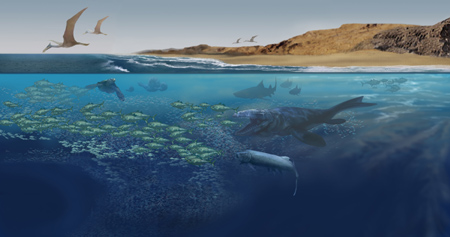65 million years ago, a mountain-sized space rock slammed into Earth. The impact created worldwide fires and acid rain. It blasted so much debris into the atmosphere that it blacked out the Sun for months, and kept the planet unusually cold for years. Most of the life on land quickly vanished, including the dinosaurs. And without sunlight, tiny marine organisms known as phytoplankton vanished, too, triggering the collapse of the entire marine food chain.
 Phytoplankton and other organisms thrived in the oceans before a mass extinction 65 million years ago. Illustration by Karen Carr, www.karencarr.com
Phytoplankton and other organisms thrived in the oceans before a mass extinction 65 million years ago. Illustration by Karen Carr, www.karencarr.comLife in the deep oceans didn’t fully recover for millions of years. But along the coastline, the recovery may have started within a century — thanks to species of phytoplankton that go into a deep hibernation when the going gets tough.
When there’s not enough food or sunlight, or the water temperature gets too uncomfortable, these microscopic organisms shut down and settle to the ocean floor. They sometimes build thicker shells for protection. They can survive in this “resting stage” for years or even decades, and burst back to life when conditions improve.
And a recent study suggests that’s just what happened 65 million years ago. When the sky went dark, some phytoplankton in shallow coastal waters went into a prolonged rest. As skies cleared years later, providing the sunlight they needed for photosynthesis, they reawakened and returned to the surface. This provided food for the few surviving animal species, igniting a revival in coastal waters around the world — a revival made possible by the long naps of tiny marine life.

